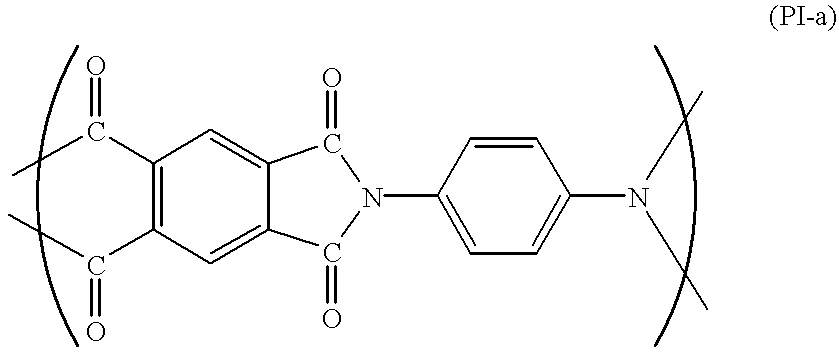Liquid crystal device and liquid crystal display apparatus having a chevron structure in monostable alignment
a liquid crystal display and chevron technology, applied in the direction of liquid crystal compositions, chemistry apparatus and processes, instruments, etc., can solve the problems of slow response speed of several ten milliseconds or above, difficulty in grading display in each pixel, and difficulty in improving the viewing angle characteristi
- Summary
- Abstract
- Description
- Claims
- Application Information
AI Technical Summary
Benefits of technology
Problems solved by technology
Method used
Image
Examples
example 2
A liquid crystal cell was prepared in the following manner.
A pair of 1.1 mm-thick glass substrates each provided with a 700 .ANG.-thick stripe electrodes of ITO film as a transparent electrode were provided.
On each of the transparent electrodes, a polyimide precursor for forming a polyimide having a recurring unit (PI-b) shown below was applied by spin coating and pre-dried at 80.degree. C. for 5 min., followed by hot-baking at 200.degree. C. for 1 hour to obtain a 200 .ANG.-thick p olyimide film. (PI-b) ##STR8##
Each of the thus-obtained polyimide film was subjected to rubbing treatment (as a uniaxial aligning treatment) with a nylon cloth in the same manner as in Example 1.
Then, on one of the substrates, silica beads (average particle size =2.0 .mu.m) were dispersed and the pair of substrates were applied to each other so that the rubbing treating axes were in parallel with each other but oppositely directed (anti-parallel relationship), thus preparing a blank cell with a uniform c...
example 3
In this example, a liquid crystal device satisfying a relationship of .delta..ltoreq.&Hcirc ; by using a pressure application treatment in combination with a liquid crystal material having a relative large Ps.
A liquid crystal composition LC-2 was prepared by mixing the following compounds in the indicated proportions.
The thus-prepared liquid crystal composition LC-2 showed the following phase transition series and physical properties. ##STR14##
Spontaneous polarization (Ps): 6.62 nC / cm.sup.2 (30.degree. C.)
Tilt angle &Hcirc ;: 22.1 degrees (30.degree. C.)
Helical pitch (SmC*): at least 20 .mu.m (30.degree. C.) (roughly calculated value due to a longer pitch)
The liquid crystal composition LC-2 was injected a blank cell (prepared in the same manner as in Example 1) in its isotropic liquid state and gradually cooled to a temperature providing chiral smectic C phase to prepare a liquid crystal device (Device C).
When the thus-prepared Device C was subjected to observation of its initial al...
example 4
A liquid crystal composition LC-3 was prepared by mixing the following compounds in the indicated proportions.
The thus-prepared liquid crystal composition LC-3 showed the following phase transition series and physical properties ##STR22##
Spontaneous polarization (Ps): 0.96 nC / cm.sup.2 (30.degree. C.)
Tilt angle &Hcirc ;: 19.1 degrees (30.degree. C.)
Helical pitch (SmC*): at least 20 .mu.m (30.degree. C.)
The liquid crystal composition LC-3 was injected into a black cell (prepared in the same manner as in Example 1) in its isotropic liquid state and gradually cooled to a temperature providing chiral smectic C phase to prepare a liquid crystal device (Device D).
When the thus-prepared Device D was subjected to observation of its initial alignment state at 30.degree. C. through a polarizing microscope, the initial alignment state was found to be bistable states comprising two domains in mixture.
The Device D was subjected to application of a rectangular wave (.+-.40 volts, 10 Hz) for 5 min....
PUM
 Login to View More
Login to View More Abstract
Description
Claims
Application Information
 Login to View More
Login to View More - R&D
- Intellectual Property
- Life Sciences
- Materials
- Tech Scout
- Unparalleled Data Quality
- Higher Quality Content
- 60% Fewer Hallucinations
Browse by: Latest US Patents, China's latest patents, Technical Efficacy Thesaurus, Application Domain, Technology Topic, Popular Technical Reports.
© 2025 PatSnap. All rights reserved.Legal|Privacy policy|Modern Slavery Act Transparency Statement|Sitemap|About US| Contact US: help@patsnap.com



